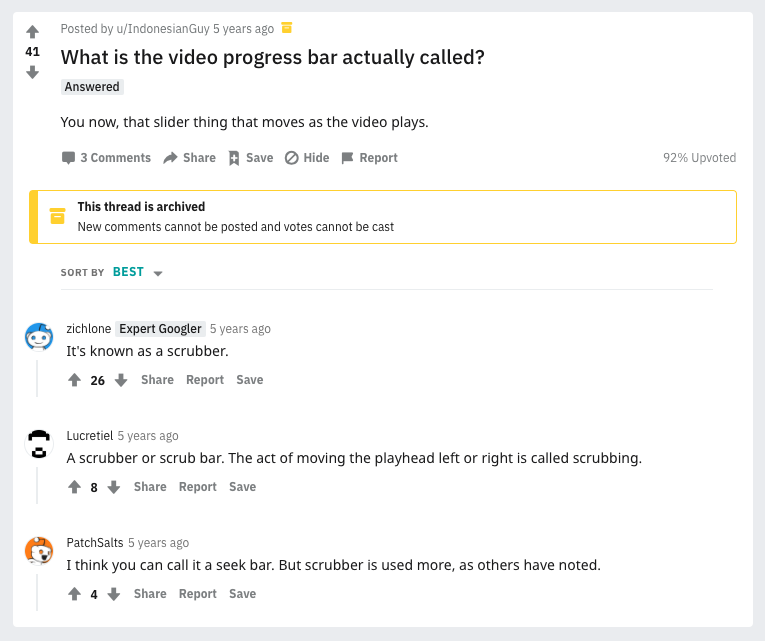

So is it a progress bar, scrub bar or play bar?
Well, that forum feed seemed to quite nicely answer the 'Googled' question: "What is that bar thing called at the bottom of a video that lets you skip to a selected part of it?"
Unfortunately, the make-up of the internet's user interface has a habit of being slightly less straight forward than this. Take Vimeo (a video hosting site) with its decision to refer to the "scrubbing bar" as a "play bar", which is no doubt short for "player bar".
But why do I care about this menial term? Well, firstly it creates some satisfying plosive alliteration in the title of this project, and second of all, Vimeo has solidified a position as the contemporary art's industry standard for hosting video online.
Scenario 1:
You visit an artist's website - or perhaps an online exhibition, click play on a video, and find out that it has no scrubbing bar. (It's likely that you have in fact just done that very thing with my video above.)
You are forced to watch the video from start to finish, with no chance to skip forward, you have no choice but to give up your predetermined right to control internet-based video content (shock horror I know).
If you happen to be one of those frustrated with having to encounter such an obstacle to your day, I will let you into a little secret, by opening the video full screen on a mobile device you should be able to escape these freedom grabbing settings and be reunited with your wedded play bar thanks to a loophole in mobile web interaction*. This 'hack' does assume that the artist has left the full-screen button on the video, if not then I'm sorry I couldn't have been of more help to you.
* This refers to videos hosted on Vimeo. Also please don't hold me to this in all cases, I'm not a technology expert.
Scenario 2 (Pt. i):
Another day, you are scrolling your social media feed on your phone and decide to follow a link to another online exhibition. This time however, the artist has really been out to ruin your day from before you even made it onto the website.
What results, lies in wait for the moment you try to reach the page from your phone, when a "for desktop viewing only" message greets you. Oh bugger... Just a few lines of code have stood between a convenient digital pathway initiated by your spur of the moment intrigue, and a disgruntled "urgh" as you reach for that dastardly laptop across the room to complete your digital journey.
The phenomenon of the "Link-In-Bio":
Whilst I didn't want to be quite as disruptive to your day as Scenario 2 (Pt. i) outlined, I gave an entry level taste of this situation to some of the visitors travelling this site.
My chosen volunteers were those of you who entered this page via the Digital Artist Residency Instagram Linktree on a mobile device (during February 2021).
A 20 second pause seemed just enough to disrupt your seamless Instagram browsing experience, and to all of you who entered this site in any other way, the above video shows what they encountered...


Scenario 2 (Pt. ii):
So you've persevered and succumbed to opening up your laptop after being denied access to the site on your phone, but there may be times when the artist has still not finished making your life a pain.
Upon re-entering the URL on your laptop (or perhaps more likely 're-Googling' the page) your slow WIFI* now struggles to load the page as you remain optimistic that you have done all that is required to reach the site.
"For Google Chrome only."
This is a particular nuisance if you have to then download a new browser, if for instance you only have Safari (the macOS default) installed. You've got off lightly if all you need to do is copy the URL across to Chrome as it was already installed.
* Just to be clear i'm not assuming you have slow WIFI – this was just for dramatic effect.
So far you've come across a couple of scenarios on this page, but how common are they? You will find that the lack of a video play bar is a fairly common device, but may be pleased to find out that the mobile and browser restrictions outlined are currently far less common in the mainstream interface between art and the internet. What's more, when you do happen to encounter such obstacles, they often tend to be clearly signposted to prevent such shocks to the user experience as described in the scenarios above.
Concluding thoughts: what's all the fuss about?
My interest began with the gallery environment and its ability to create parameters. Upon entering such a space, you simultaneously give up your total freedom of choice – things are where they are, they are what they are, looping videos start when they start, screenings occur at specific times and nothing can be paused. Spoken and unspoken rules dictate one's behaviour in art spaces, but what are the rules governing viewing art on the internet?
The parameters imposed by curated space are what lead to the desire of viewing art in the flesh. An incentive that's worth the pilgrimage in the eyes of the viewer, whether a member of public or art critic, across oceans or on the local bus. This deployment of parameters is not limited to the physical world, they can be replicated in the virtual one too. From the mobile vs desktop viewing experience, to internet browsers presenting content differently; if an artist deems any such virtual condition unsuitable, the condition can be simply removed, just like in the real world.
Binary code provides a nice visualisation of this. Binary is comprised of "1's" and "0's" that reflect "On's" and "Off's". To decide whether the outcome will be On or Off we need a rule:
Say:
If x = y then Outcome = Off
But:
If x ≠ y then Outcome = On
("≠" means not equal to)
All I'm really saying here is that online conditions can be controlled as much as any other environment that art may find itself in. But why do we so easily accept parameters in the real world, yet suffer such great frustration when encountering them on the internet?
The struggle lies in the fundamental idea that the internet exists with principles that oppose the specificity of art. By providing an anytime gateway to anything, the internet fuels a restless mindset within users that's driven by a limitless, instantaneous consumption of content. 'On demand' summarises this online experience through providing a 'fix' to our craving for more, and this fix is what leaves us so agitated when experiencing anything other than the seemingly ritualistic laws of internet consumption that surround freedom and accessibility.
When it comes to art and the internet, two different levels of magnitude sit side by side; on one hand the internet takes milliseconds to bring up a new page, but on the other it takes exponentially longer to move between exhibitions in real life. Here lies the point of tension between a moment where the viewer expresses willingness to invest time to indulge their interest in art, and the deep routed viewing expectations that exist when using digital devices and platforms.
This tension shows itself when the smallest delay in reaching an online space causes a hugely irrational response in comparison to the greater sacrifices made in our relationship with 'in the flesh' art. The un-harmonious pairing of these two juxtaposed conventions next to each other makes it all too easy for the expectations of experiencing art to fade away when approaching on a technological pilgrimage.
I should make it clear that I'm not accusing the viewer of anything. I admit myself to finding it difficult to differentiate between everyday banalities and encountering art when using the same digital portal. It could be that the only way to overcome this separation is through personally reflecting on what it means to simultaneously be a user of the internet and a viewer of art.
With the demand for online viewing increasing, the fabric of the internet provides the ability to allow conditions to be set that can both satisfy this growing mode of mass viewership and remain sympathetic to the importance of how a user encounters work. Therefore, as much as it pains the viewer to not be able to rewind, fast forward, watch on their mobile or have to download new software – having to 'suffer' viewing parameters is ultimately what makes the differential between ordinary and curated space, and that's why we go to see art right?
So next time you come across a video with no play bar, try to resist the urge to use my above hack to overcome it and just accept the parameters offered.
To see more of my work visit: www.james-scott.uk





